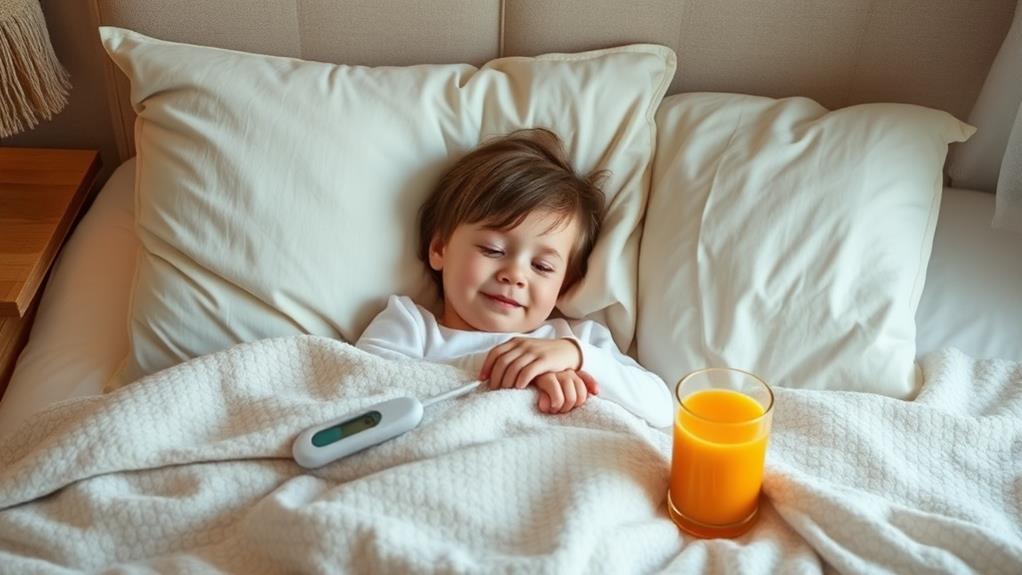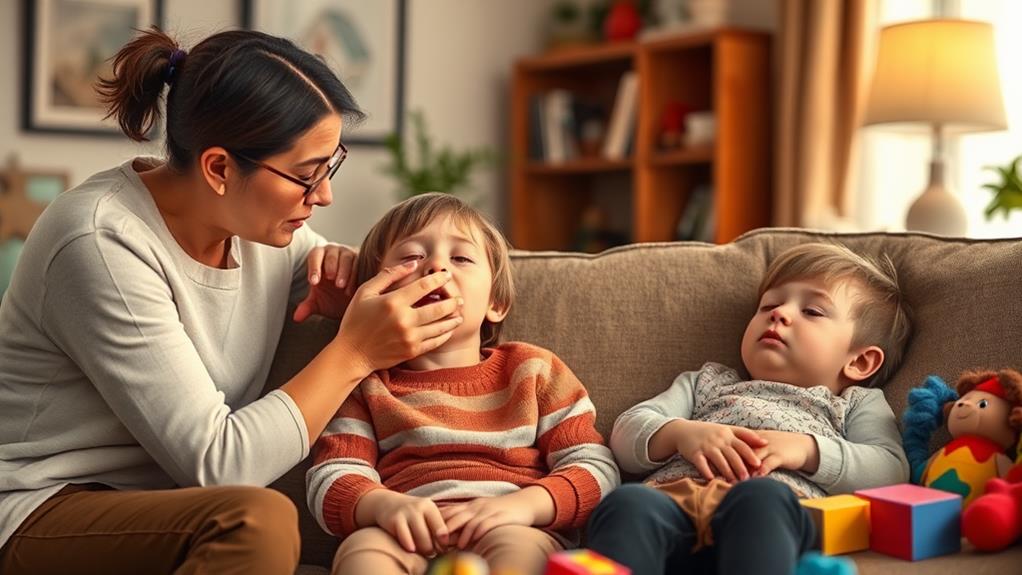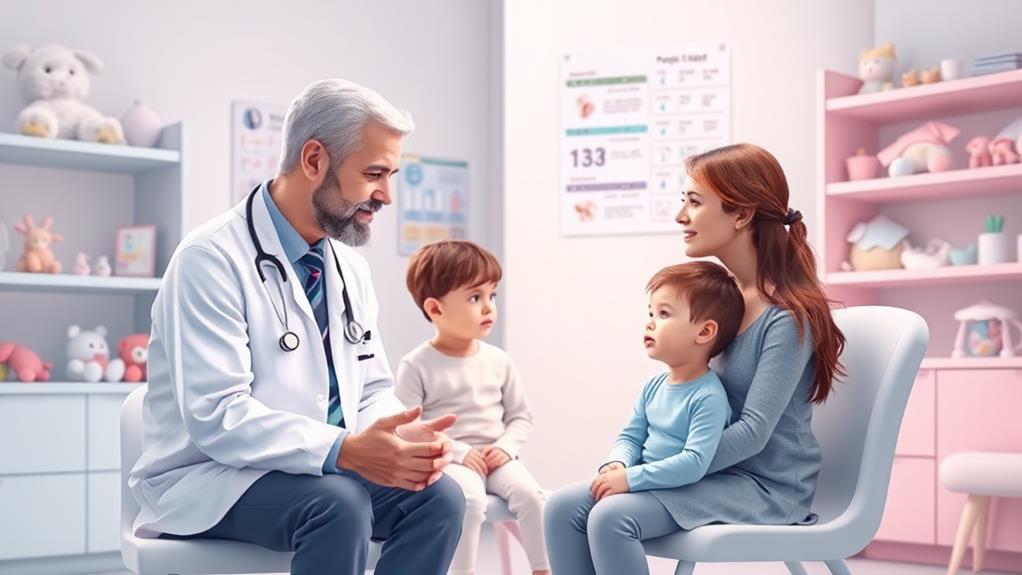When you notice your child feeling unusually fatigued or complaining of a sore throat, it might raise some concerns about mononucleosis, commonly known as mono. This viral infection, primarily caused by the Epstein-Barr virus, can lead to various symptoms that are often mistaken for other conditions. You might be wondering about the specific causes, how to recognize the symptoms, and the best approaches for treatment. Understanding these aspects is crucial, especially since early intervention can make a significant difference in recovery. So, what exactly should you look out for?
Understanding Mononucleosis

Mononucleosis, often called "mono," is an infectious illness primarily caused by the Epstein-Barr virus. This virus spreads through saliva, so sharing drinks, utensils, or even a kiss can lead to infection.
If you think your child might've mono, it's important to be aware of both the symptoms and how it can affect their daily life.
Mono often makes kids feel extremely tired and sluggish, which can be concerning for parents. Along with fatigue, symptoms may include a sore throat, swollen lymph nodes, and fever. These signs can sometimes mimic other illnesses, so it's essential to consult a healthcare provider for a proper diagnosis.
While mono is generally not serious, it can require some time off from school and activities. Your child might need extra rest and care during this period to recover fully. Encouraging hydration and a balanced diet can also help.
Understanding mono is the first step in managing its effects. By staying informed and paying attention to your child's symptoms, you can help them navigate through this challenging time with care and support.
Common Causes of Mono
Understanding how mono spreads can help you take preventive measures. The primary cause of mononucleosis, often called "mono," is the Epstein-Barr virus (EBV). This virus is quite common and usually spreads through saliva. You might catch it by sharing drinks, utensils, or even by kissing someone who's infected. It's like an unwelcome guest at a party—once it's there, it can linger and cause trouble!
Aside from direct contact with saliva, mono can also spread through other means. For instance, you could get it from being around someone who coughs or sneezes, as the virus can be present in respiratory secretions.
Additionally, if you're in close quarters with a person who's sick, like in a classroom or on a school bus, your risk increases.
It's also worth noting that mono can be transmitted even if the infected person isn't showing symptoms. That's why it's crucial to practice good hygiene, like washing your hands regularly and not sharing personal items.
Recognizing Symptoms in Children

When it comes to recognizing symptoms of mono in children, parents should be vigilant. Mono, or infectious mononucleosis, often sneaks in with a set of common signs that you can't ignore.
First, watch for persistent fatigue. If your child seems unusually tired, even after a good night's sleep, it might be a red flag. Sore throat is another key symptom; it can feel like a bad cold or strep throat, often accompanied by swollen tonsils.
Don't forget about fever! A mild to moderate fever can signal that something's not quite right. You may also notice swollen lymph nodes, particularly in the neck and armpits. These swollen glands can be uncomfortable, and your child might complain about them.
Headaches and body aches are also common complaints, making your little one feel generally unwell.
If you see a combination of these symptoms persisting for more than a few days, it's essential to consult a healthcare professional. Early recognition can lead to better management and quicker recovery, so keep an eye out for those signs.
After all, being proactive about your child's health is the best approach!
Diagnosis and Testing Methods
Diagnosing mono in children can be straightforward, but it often requires a combination of clinical evaluation and specific tests. First, your doctor will start by asking about your child's symptoms and medical history. They'll look for common signs, like fever, sore throat, and swollen lymph nodes. This initial assessment is crucial, as it helps shape the next steps.
If mono is suspected, the doctor may perform a physical examination to check for swollen glands in the neck and abdomen. To confirm the diagnosis, they'll likely order blood tests. The most common test is the heterophile antibody test, often known as the "Monospot" test. This test looks for antibodies that indicate an infection with the Epstein-Barr virus, the primary cause of mono.
In some cases, your doctor might recommend additional blood tests to measure specific antibodies or check for other possible infections. These tests help rule out other illnesses that could mimic mono symptoms.
Treatment Options for Mono

Once your child's diagnosis of mono is confirmed, it's essential to focus on treatment options that can help alleviate symptoms and support recovery. While there's no specific cure for mono, you can take steps to ease your child's discomfort.
First, encourage plenty of rest. Sleep is crucial for recovery, so make sure your child gets enough downtime.
Hydration is equally important; encourage them to drink plenty of fluids, like water or herbal tea, to stay hydrated and soothe a sore throat. Over-the-counter medications, such as acetaminophen or ibuprofen, can help reduce fever and relieve pain. Just remember to follow the dosage instructions carefully.
A soft, bland diet may also be helpful, especially if your child has a sore throat. Foods like applesauce, mashed potatoes, or yogurt can be easier to swallow.
Lastly, avoid strenuous activities and sports for a few weeks, as mono can affect the spleen and increase the risk of injury.
